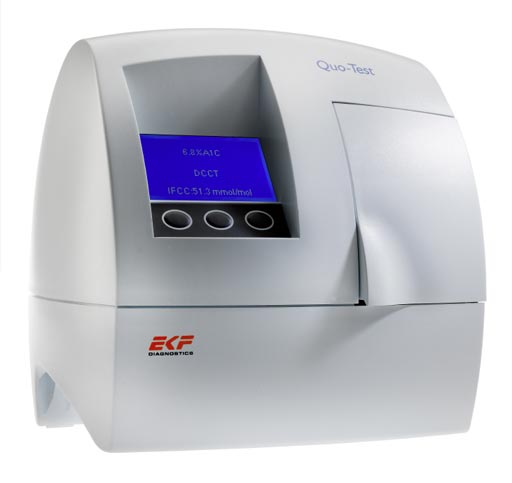POC Analyzer Compared with HPLC Method
By LabMedica International staff writers
Posted on 20 Jun 2017
The measurement of the glycated fraction of hemoglobin (HbA1c) has been recommended to diagnose diabetes, in addition to monitoring glycemic control. HbA1c reflects long-term glycemic control over the preceding two to three months as opposed to glycemic control at a single point in time.Posted on 20 Jun 2017
Point of Care Testing (POCT) enables measurement of HbA1c in a clinical setting without the waiting time associated with laboratory testing or the high level of expertise required; however, for POCT methods to be used effectively they must be comparable to those used in a clinical laboratory.

Image: The Quo-Test HbA1c fully automated analyzer uses patented boronate fluorescence quenching technology to measure glycated hemoglobin from a 4 μL sample taken from a finger prick or venous whole blood (Photo courtesy of EKF Diagnostics).
Scientists at Swansea University assayed EDTA blood samples from 100 subjects with and without diabetes. HbA1c was determined using the BioRad D10 high performance liquid chromatography (HPLC) analyzer as the laboratory reference method and the Quo-Test POCT analyzer. The BioRad D10 required 10 μL and the Quo-Test 4 μL of whole blood. Quality control was carried out every day of testing using BioRad Lyphocheck Hemoglobin A1C Controls for the D10 and EKF Diagnostics Quo-Test A1c Controls for the Quo-Test.
The investigators found a median HbA1c was 60 mmol/mol (Interquartile range (IQR) 44.0–71.2) (7.6% (6.17–8.66)) and 62 mmol/mol (45.0–69.0) (7.8% (6.27–8.46) for D10 and Quo-Test, respectively, with very good agreement. Mean (range) intra- and inter-assay variation was 1.2% (0.0–2.7%) and 1.6% (0.0–2.7%) for the D10 and 3.5% (0.0–6.7%) and 2.7% (0.7–5.1%) for the Quo-Test. Mean change in HbA1c after 28 days storage at −20 °C was −0.7% and +0.3% for D10 and Quo-Test respectively. Compared to the D10, Quo-Test showed 98% agreement for the diagnosis of glucose intolerance, impaired glucose tolerance and type 2 diabetes mellitus (T2DM) and 100% for the diagnosis of T2DM.
The authors concluded that the performance of the Quo-Test POCT analyzer is similar to that of a laboratory HPLC analyzer and good agreement was found between the D10 and Quo-Test and seen across a wide HbA1c range. The Quo-Test POCT analyzer should be considered for diagnostic purposes by the various professional organization that issue clinical guidelines. The study will be published in the August 2017 issue of the journal Practical Laboratory Medicine.




 assay.jpg)








